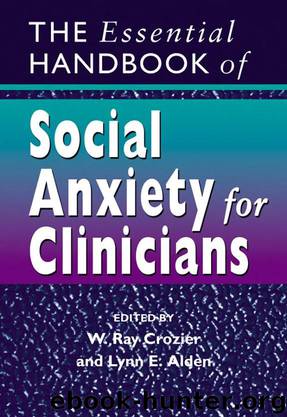The Essential Handbook of Social Anxiety for Clinicians by W. Ray Crozier & Lynn E. Alden

Author:W. Ray Crozier & Lynn E. Alden
Language: eng
Format: mobi
Tags: Social Psychology, Psychology, 0470022671.pdf, General
ISBN: 9780470022672
Publisher: Wiley
Published: 2005-03-10T22:00:00+00:00
Chapter 9
A Cognitive Perspective on
Social Phobia
David M. Clark
the cognitive model
Processing in Social Situations
Processing of the self as a social object
Safety behaviours
Somatic and Cognitive Symptoms
Processing of External Social Cues
Processing before and after a Social Situation
empirical studies of the cognitive model
Hypotheses
Conclusions
a theory derived cognitive treatment
Therapeutic Relationship
Deriving an Idiosyncratic Version of the Model
Manipulation of Self-focused Attention and Safety Behaviours
Video and Audio Feedback
Shift of Attention and Interrogation of the Social Environment
Dealing with Anticipatory and Post-event Processing
Dealing with Assumptions
effectiveness of the cognitive treatment
acknowledgements
references
The persistence of social phobia is a puzzle. Individuals with other phobias such
as claustrophobia, height phobia, and small animal phobias are able to success-
fully avoid most encounters with their phobic object, and it is generally thought
The Essential Handbook of Social Anxiety for Clinicians.
Edited by W. Ray Crozier and Lynn E. Alden.
© 2005 John Wiley & Sons Ltd.
194
DAVID M. CLARK
that this avoidance is the main reason for the persistence of their fears. In con-
trast, the nature of modern society is such that patients with social phobia often
have to enter feared social situations. This distinction is recognized in recent versions of the Diagnostic and Statistical Manual for Mental Disorders (APA, 1987, 1994) where avoidance is necessary for the diagnosis of all phobias except for
social phobia where it is specified that the phobia situation must be either
“avoided or endured with intense distress” (APA, 1994, p. 417; emphasis added).
Why does social phobia persist despite regular exposure to feared social situa-
tions? The present chapter provides an overview of a recent cognitive model of
social phobia (Clark & Wells, 1995; Clark, 1997; Wells, 1997, 1998; Wells & Clark, 1997) that was specifically developed to explain such persistence.1 Following a
description of the model, research testing key aspects of the model is summa-
rized, a treatment programme which aims to reverse the maintenance processes
specified in the model is outlined, and preliminary evaluations of the treatment
and its components are reviewed.
THE COGNITIVE MODEL
For the purpose of exposition, the model is divided into two parts. The first part
concerns what happens when a social phobic enters a feared social situation. The
second concerns what happens prior to entering, and after leaving a social
situation.
Processing in Social Situations
Figure 9.1 illustrates the processes that Clark and Wells suggest occur when a
social phobic enters a feared social situation. On the basis of early experience,
patients with social phobia develop a series of assumptions about themselves and
their social world. The assumptions can be divided into three categories:
•
Excessively high standards for social performance, e.g., “I must not show any signs of weakness”, “I must always sound intelligent and fluent”, “I should
only speak when other people pause”, “I should always have something inter-
esting to say”.
•
Conditional beliefs concerning the consequences of performing in a certain
way, e.g., “If I disagree with someone, they will think I am stupid/will reject me”, “If my hands shake/I blush/or show other signs of anxiety, people will
think I am incompetent/odd/stupid”, “If I am quiet, people will think I am
boring”, “If people get to know me, they won’t like me”.
1 The Clark and Wells model draws heavily on the writings of earlier theorists, especially
Download
This site does not store any files on its server. We only index and link to content provided by other sites. Please contact the content providers to delete copyright contents if any and email us, we'll remove relevant links or contents immediately.
Should I Stay or Should I Go? by Ramani Durvasula(7429)
Why We Sleep: Unlocking the Power of Sleep and Dreams by Matthew Walker(6352)
Fear by Osho(4495)
Flow by Mihaly Csikszentmihalyi(4491)
Rising Strong by Brene Brown(4192)
Why We Sleep by Matthew Walker(4190)
How to Change Your Mind by Michael Pollan(4112)
Too Much and Not the Mood by Durga Chew-Bose(4091)
The Hacking of the American Mind by Robert H. Lustig(4085)
Lost Connections by Johann Hari(3920)
He's Just Not That Into You by Greg Behrendt & Liz Tuccillo(3713)
Evolve Your Brain by Joe Dispenza(3503)
The Courage to Be Disliked by Ichiro Kishimi & Fumitake Koga(3255)
Crazy Is My Superpower by A.J. Mendez Brooks(3204)
What If This Were Enough? by Heather Havrilesky(3197)
Resisting Happiness by Matthew Kelly(3194)
Descartes' Error by Antonio Damasio(3166)
The Book of Human Emotions by Tiffany Watt Smith(3141)
In Cold Blood by Truman Capote(3136)
